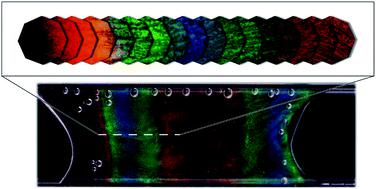当前位置:
X-MOL 学术
›
Faraday Discuss.
›
论文详情
Our official English website, www.x-mol.net, welcomes your feedback! (Note: you will need to create a separate account there.)
Playing the blues, the greens and the reds with cellulose-based structural colours.
Faraday Discussions ( IF 3.4 ) Pub Date : 2020-03-18 , DOI: 10.1039/d0fd00020e Ricardo Chagas 1 , Pedro E S Silva 1 , Susete N Fernandes 1 , Slobodan Žumer 2 , Maria Helena Godinho 1
Faraday Discussions ( IF 3.4 ) Pub Date : 2020-03-18 , DOI: 10.1039/d0fd00020e Ricardo Chagas 1 , Pedro E S Silva 1 , Susete N Fernandes 1 , Slobodan Žumer 2 , Maria Helena Godinho 1
Affiliation

|
Structural vivid colours can arise from the interference of light reflected from structures exhibiting periodicity on scales in the range of visible wavelengths. This effect is observed with light reflected from cell-walls of some plants and exoskeletons of certain insects. Sometimes the colour sequence observed for these structures consists of nearly circular concentric rings that vary in colour from Red, Orange, Yellow, Green, Cyan to Blue, from the periphery to the centre, similarly to the colour scheme sequence observed for the rainbow (ROYGB). The sequence of colours has been found for solid films obtained from droplets of aqueous cellulose nanocrystals (CNCs) suspensions and attributed to a “coffee ring” effect. In this work, coloured lyotropic solutions and solid films obtained from a cellulose derivative in the presence of trifluoroacetic acid (TFA), which acts as a “reactive solvent”, are revisited. The systems were investigated with spectroscopy, using circularly and linearly polarised light, coupled with a polarised optical microscope (POM) and scanning electron microscopy (SEM). The lyotropic cholesteric liquid crystalline solutions were confined in capillaries to simplify 1D molecular diffusion along the capillary where an unexpected sequence of the structural colours was observed. The development and reappearance of the sequence of vivid colours seem consistent with the reaction–diffusion of the “reactive solvent” in the presence of the cellulosic chains. The strong TFA acts as an auto-catalyst for the chemical reaction between TFA and the hydroxyl groups, existing along the cellulosic chain, and diffuses to the top and bottom along the capillaries, carrying dissolved cellulosic chains. Uncovering the precise mechanism of colour sequence and evolution over time in cellulosic lyotropic solutions has important implications for future optical/sensors applications and for the understanding of the development of cellulose-based structures in nature.
中文翻译:

使用基于纤维素的结构色演奏蓝色、绿色和红色。
结构鲜艳的颜色可能来自结构反射的光的干涉,这些结构在可见波长范围内的尺度上表现出周期性。这种效应是通过从某些植物的细胞壁和某些昆虫的外骨骼反射的光来观察到的。有时,观察到的这些结构的颜色序列由近乎圆形的同心环组成,这些环的颜色从红色、橙色、黄色、绿色、青色到蓝色,从外围到中心变化,类似于为彩虹观察到的配色方案序列 (ROYGB )。已经发现从水性纤维素纳米晶体 (CNC) 悬浮液的液滴获得的固体薄膜的颜色序列,并归因于“咖啡环”效应。在这项工作中,在作为“反应溶剂”的三氟乙酸 (TFA) 存在下,从纤维素衍生物获得的彩色溶致溶液和固体薄膜被重新审视。使用圆偏振光和线偏振光,结合偏振光学显微镜 (POM) 和扫描电子显微镜 (SEM),对系统进行了光谱学研究。溶致胆甾型液晶溶液被限制在毛细管中以简化沿毛细管的一维分子扩散,在那里观察到意想不到的结构颜色序列。一系列鲜艳颜色的发展和再现似乎与纤维素链存在下“反应性溶剂”的反应扩散一致。强 TFA 作为 TFA 与羟基之间化学反应的自动催化剂,沿着纤维素链存在,并沿着毛细血管扩散到顶部和底部,携带溶解的纤维素链。揭示纤维素溶致溶液中颜色序列和随时间演变的精确机制对于未来的光学/传感器应用以及理解自然界中基于纤维素的结构的发展具有重要意义。
更新日期:2020-03-18
中文翻译:

使用基于纤维素的结构色演奏蓝色、绿色和红色。
结构鲜艳的颜色可能来自结构反射的光的干涉,这些结构在可见波长范围内的尺度上表现出周期性。这种效应是通过从某些植物的细胞壁和某些昆虫的外骨骼反射的光来观察到的。有时,观察到的这些结构的颜色序列由近乎圆形的同心环组成,这些环的颜色从红色、橙色、黄色、绿色、青色到蓝色,从外围到中心变化,类似于为彩虹观察到的配色方案序列 (ROYGB )。已经发现从水性纤维素纳米晶体 (CNC) 悬浮液的液滴获得的固体薄膜的颜色序列,并归因于“咖啡环”效应。在这项工作中,在作为“反应溶剂”的三氟乙酸 (TFA) 存在下,从纤维素衍生物获得的彩色溶致溶液和固体薄膜被重新审视。使用圆偏振光和线偏振光,结合偏振光学显微镜 (POM) 和扫描电子显微镜 (SEM),对系统进行了光谱学研究。溶致胆甾型液晶溶液被限制在毛细管中以简化沿毛细管的一维分子扩散,在那里观察到意想不到的结构颜色序列。一系列鲜艳颜色的发展和再现似乎与纤维素链存在下“反应性溶剂”的反应扩散一致。强 TFA 作为 TFA 与羟基之间化学反应的自动催化剂,沿着纤维素链存在,并沿着毛细血管扩散到顶部和底部,携带溶解的纤维素链。揭示纤维素溶致溶液中颜色序列和随时间演变的精确机制对于未来的光学/传感器应用以及理解自然界中基于纤维素的结构的发展具有重要意义。



























 京公网安备 11010802027423号
京公网安备 11010802027423号